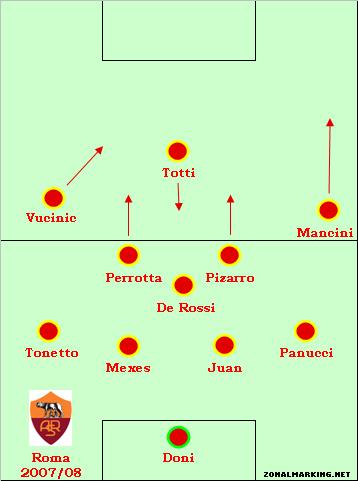
Unsung Heroes: False Nine
False Nine’s in football have become one of the most mainstream striker roles in history. Ever since Vincente Del Bosque used the role in the 2012 World Cup to win the competition, more and more teams have been using this role in their team; some to no avail, and some have toppled giants. But what is a False Nine and where did it come from? Who is considered the best False Nine? How can it be implemented correctly into Football Manager?
History of False Nine
False Nine’s have been used throughout footballing history sporadically. History’s first False Nine is considered to be Juan Pelegrino Anselmo in the 1930 World Cup. Although not used much, other players started to follow suit. Matthias Sindelar and Nandor Hidegkuti played as False Nine’s in the 30’s and 50’s. In terms of modern football, Luciano Spalletti used Francesco Totti as a False Nine. Spalletti’s tactic resulted in a record breaking 11 game victory streak in February 2006, a record in Serie A. This was the first time that a False Nine was used without any real striker up front.
Six years later, Cesc Fabregas was used as a False Nine. With two more attacking players playing further forward in Spain’s Euro victory. Since the end of 2012, many teams started using False Nine’s in their own attempts at creating genius plays. One particular example of a False Nine being used for brilliance is Lionel Messi, under Pep Guardiola and later Tito Vilanova. As the role developed, tactics against it also developed. Jose Mourinho’s ‘park the bus’ tactic was deemed effective at creating congestion in the midfield. It forbids the False Nine from using the space he needs to be creative.

False Nine Role
So now the history lesson is complete, what exactly is a False Nine? What kind of attributes would one need to be able to play as a False Nine?
Simply, a False Nine is a player who plays at the front of the pitch, acting as a striker. When his team attacks, the False Nine will periodically drop down into the midfield to pick up the ball and drive his team onwards. He either carves out a chance for himself or laying it off to either the wingers or his striker partner. It is essential to have Inside Forwards unless you’re playing more strikers up front. Similar to a Deep Lying Playmaker, the False Nine needs a lot of space to be able to work his magic. He also needs a good amount of time to be able to pick out a pass or decide on what to do.
In terms of Football Manager, his mental attributes would need to be very good, to be able to not only hold onto the ball but be able to make quick decisions on what he wants to do with it. Aside from mental attributes, a False nine also needs decent physical attributes, but this, of course, depends on the type of player you want to play. One type of False Nine can be used to carve out his own chances, making blinding runs through the defence and scoring his own goals, or laying off a pass to a Box to Box midfielder or Winger. Another type of False Nine is the one that picks up the ball deep and immediately moves it to one of his more attacking teammates, getting important assists. To make things easier, we’ll split these two types of players into different categories: passive and active False Nine’s.
Lionel Messi – The perfect False Nine
A very typical example of a False Nine is Lionel Messi, the GOAT. Attribute wise, he has everything needed for a False Nine to flourish. His pace and agility allow him to dance around defenders and midfielders alike, often doing it all at once. His flair and technique allow his dribbles to get him into goalscoring positions. And his finishing and long shots allow him to score goals from pretty much anywhere on the pitch. Let alone his passing attributes that allow him to also get many assists per season. Messi is one of the False Nine’s who can pick up the ball deep and run through the defence without issue. He has shown time and time again that his skill and ability allow him to be the perfect False Nine, and his statistics show just how good he is. Lionel Messi is an example of an active False Nine.

Francesco Totti
We talked a bit before about Spaletti’s Roma side in the 2000’s. Francesco Totti was used as a non-traditional False Nine for the Italian side. The famous Italian striker recorded a good amount of both goals and assists under the coach, as when the midfield received the ball with De Rossi, the midfielders around him would run forward along with the wingers, who would often cut inside.
Whilst this attacking move was going on, Totti dropped back and opened himself up for a pass. With four players running forwards and one running back, De Rossi had options ahead of him of what to do with the ball. When Totti recevied the ball, the opposition defenders would be confused. Why would a striker drop so deep? Should I go to him or remain in my position? Either way, the defenders would get carved apart from the Roma strike force, allowing them to score many goals this way. Totti knew how to score goals, and he did score many goals in this position. But his main task was to get the ball further forward, maybe to a winger, and then making his way back into the box. He is an example of a more passive False Nine.

How does it work in Football Manager?
Football Manager tries to simulate real football, with physics and AI intelligence being at the forefront of the realism, it does a good job at acting like real football. But how exactly can you use a False Nine in your team?
As I said before, a False Nine needs creative freedom to flourish. So if we look in terms of attributes, a False Nine’s role instructions allow him (by default) to take more risks and dribble more. So it’s only normal that a False Nine would need good dribbling skills. Good technique, composure, decisions, flair and agility are all very important for this role. Depending on how you want your False Nine to play (active or passive), you’d also want your player to have good passing and finishing attributes. Everything else is a bonus. Once you’ve found the player you want to use, the next thing you’ll want to focus on is your tactics.

The way this Barcelona team is setup (barring all instructions) is a good way of setting up your team. Busquets gets the ball, Vidal, Fati, Griezmann and Coutinho run forwards, whilst Messi comes back down to pick up possession. At this point in time, Messi would then have options to either pass it to one of the other players around him or go for goal himself.
Conclusion
All in all, there is no ‘perfect’ way to set up your team. It all depends on what players you use and in what formations. If Busquets was injured and I had to play someone else in the Deep Lying Playmaker position, he perhaps wouldn’t be able to hold the ball long enough to lay a pass off to Messi, at which point the False Nine would become absolutely useless.
Like all other roles on the pitch, they all rely on each other to make the tactic work. Football, afterall, is a team game. If one link is weak, the rest of the team could be penalised for it. A False Nine is an incredibly innovative role in football. It can be used brilliantly, and you could end up being champions of the world by using it, or you could flop and be sacked in a fortnight.
Did you like this article? Want to read more?